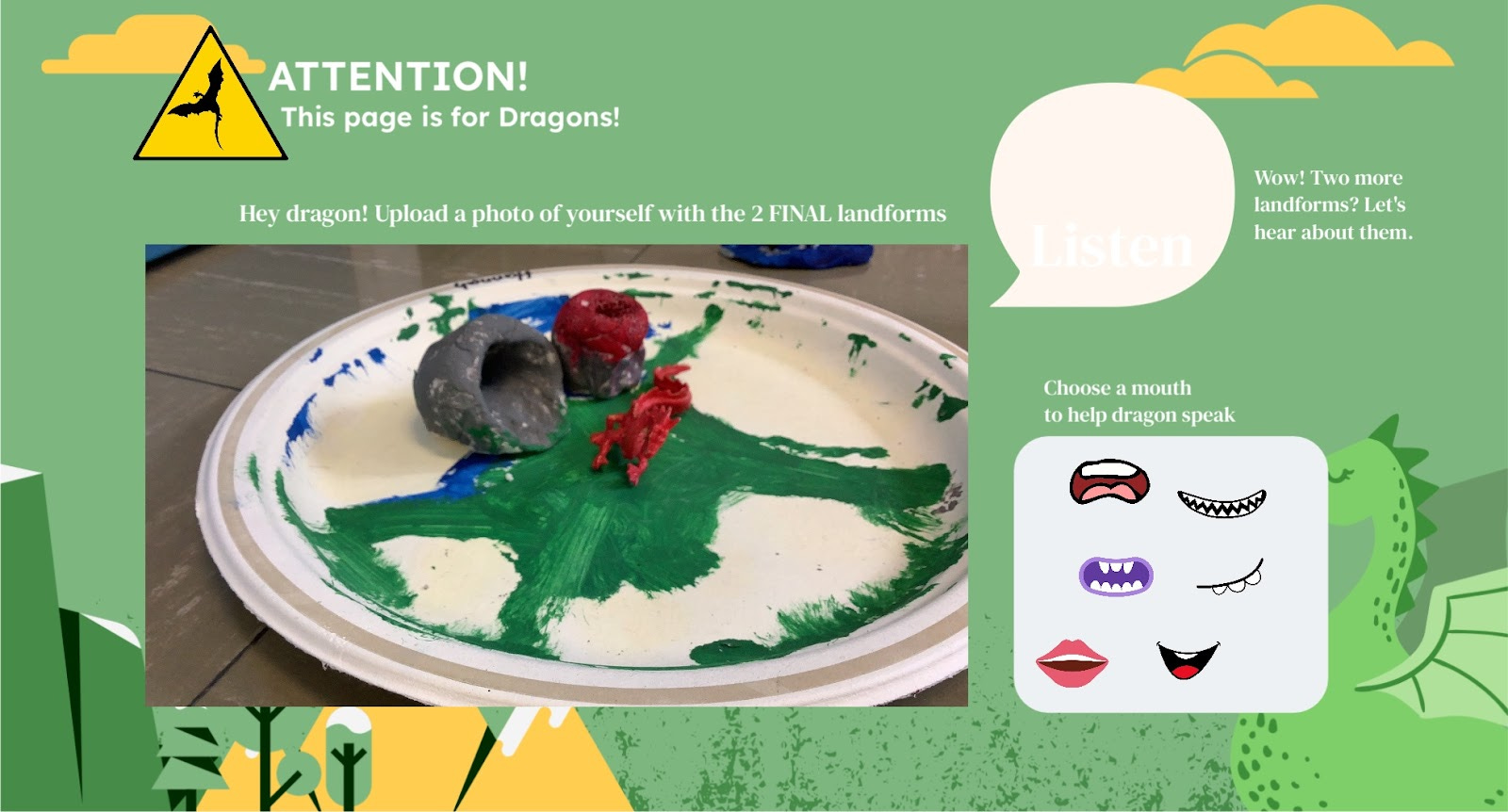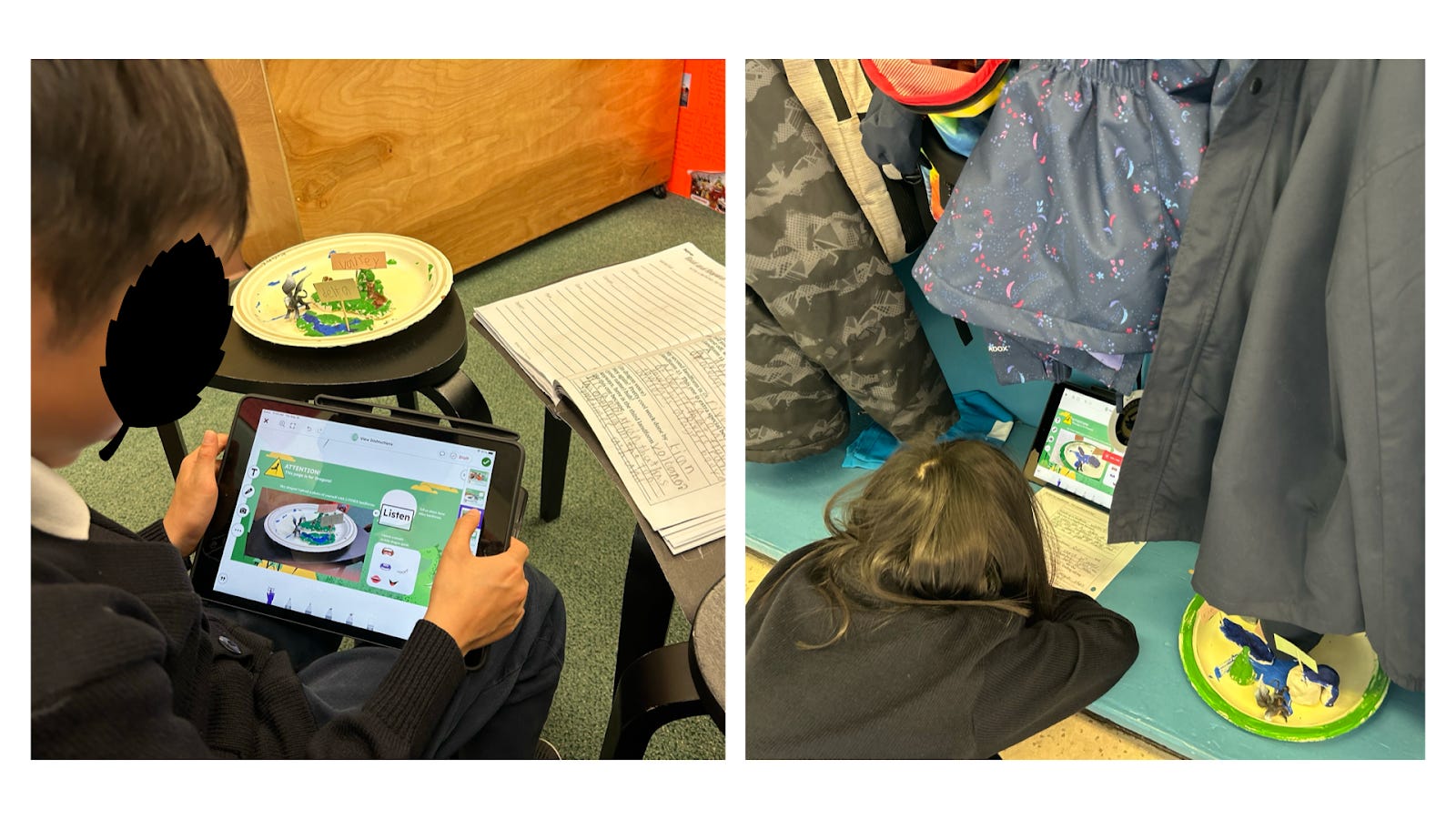Special Edition Interview 🎙️
This week, we’re excited to present an interview with Grade 3 teacher Heather and two of her students about a creative project we assisted with that combined the Science, Language Arts, and Art Education curriculums — that’s right, we’re getting cross-curricular! It’s well worth the read, as we delve into assessment, the core competencies involved, what went well, the challenges that were navigated, and advice for anyone (teacher or student) looking to do something similar. Let’s dive in.
(Editor’s note: Student names in this article have been changed to protect privacy)
Landforms and Dragons 🐲
🤓 Carlo: Thanks for joining us, 😊 Heather. We loved helping with this project. Can you tell us again what the original goal for the project was?
😊 Heather: Sure. My main goal was to have a fun and creative way for students to identify and become familiar with the landforms we find in British Columbia.

🤓: And where did dragons fit into this project?
😊: In Language Arts, we were reading a novel called "Jeremy Thatcher, Dragon Hatcher." I wanted to merge this with the landforms, so I thought it would be cool to have toy dragons live on the landforms they created. I timed the dragon toy reveal with the chapter of the book when the dragon hatched. In the book, the main character discovers that dragons chose their owners, so I set up a dragon egg 🥚 (a large bowl) that students had to blindly reach into and pull out their dragon. The students loved it!

🤓: That’s delightful. What were you trying to assess with this project? And were there core competency tie-ins?
😊: There were a few things I was looking to assess:
- 📚 For Language Arts, I was looking at their reading and comprehension, and their ability to review and share what they know. We did this in literature circles, where each student had to take turns between the roles of artful artist, friendly passage investigator, and word wizard.
- 🧪 For Science, they needed to share what they learned about some major local landforms like mountains, hills, plateaus, valleys, riverbeds, deltas, glaciers, etc. They demonstrated their knowledge through the crafting of dioramas; and they needed to create an oral narrative about landforms, which they did through the use of their dragons.
- 🎨 And for Art Education, they created their landform continent using playdough. They had to create four local landforms and were able to add two of their own choice. As they studied landforms, they understood the criteria of making each landform “realistic.”
As for core competency tie-ins, there were lots, and they changed throughout the different stages of the project. For example, to make the landforms, I gave everyone a recipe for playdough that they had to make at home with their parents. When using their hands and imagination to mould the landforms with the playdough, their creative thinking was definitely engaged. And when it came time to document their work, they had to partner up and collaborate with each other and communicate their work in Seesaw.
Tying it Together with Seesaw 🪢
🤓: Speaking of Seesaw, we worked together to create templates for the students. How did you feel that went?
😊: I really appreciated your help tying everything together with Seesaw. It allowed students to document their work and share with their parents. The students responded to the activity by taking photos and recording audio. The big creative spin on it was having them speak in the voice of their dragon. It was the dragon that explained to parents how their kids made a landform for them to live on.
🤓: It was super cute! I joined in on the day of the recording to lend a hand. They turned out so well.
😊: Yeah, the different parts of the template all came together. The different mouths they could choose from for their dragon to speak and the easy way for them to upload their pictures and audio. The students had so much fun with it.

The Student’s Perspective 👀
🤓: Speaking of students, welcome, 👦🏻 Sam and 👧🏻 Hazel! We’re looking at your projects and wondering what was something you really liked about working on this?
👦🏻 Sam: I liked that we got to have our own dragons. It was fun to try out different dragon voices. I also liked making the continents with our homemade playdough — I don’t really play with playdough that much, so it was fun to play with our hands at school.
👧🏻 Hazel: I loved playing with playdough at home — and now I got to do it at school! It was my first time painting on the playdough, so I learned something new. After my landforms dried out, I was shocked to find it cracking, but it was cool, because it made it look like a real volcano.
🤓: You’re both really into that playdough! What challenges did you run into?
👦🏻: We had to research and draw our plan first before playing with the playdough. I wasn’t sure at first what landforms we have in BC, and I thought that was tough. Taking pictures and recording our voices in the classroom was a challenge, too. Sometimes it was so loud! You could hear other kids in the background of our recordings.
👧🏻: Making dragon voices was hard. Also my playdough was not that good so I had to borrow some from my classmate. I wasn’t sure how to make mountains and volcanoes, and the trees were hard to make. Also, I had to restart recording a few times because of the noise. Taking photos on the iPad was tough because we had to make sure that the picture was clear – it took me a few tries.

🤓: How did you handle all that noise, Sam? And how about those playdough challenges, Hazel?
👦🏻: For the noise, we had to record a bunch of times. We moved to a different, quieter spot in the school, which helped a lot.
👧🏻: For the continents, I asked my friend, Chloe, how to make a cave. We made a ball and I had to stick my finger in to make a hole and shape it. I learned new skills on how to work with playdough!
🤓: And what would you two do differently next time?
👦🏻: I would change my dragon voice and redo my sculptures now that I learned how to play with playdough better. We also had a script to use that our teacher gave us — next time I would write my own from scratch!
👧🏻: I would try to use all the time I have to practice a better dragon voice. And now that I know how to make playdough, I would make it better next time.

🤓: Sam and Hazel, last question for both of you. Any advice you would give another student doing this project?
👦🏻: Find a quiet room and work with a partner. They can help you make things like the landforms, and you can record together.
👧🏻: Don’t glue your landforms down on the base until after you’ve taken the pictures. We had to take photos of the different landforms, and it would be too hard to move them around if they’re glued. I also think that you should have a friend help hold the iPad when recording.
Mirror, Mirror on the Wall, How Did This Project Go Overall? 🪞
🤓: Thank you, Sam and Hazel! So back to you, 😊 Heather — how did this project stack up with your original goal?
😊: The project turned out better than expected! The parents didn’t see the final Seesaw posts that tied everything together until our student-led conferences. When they did, I could hear them giggling with surprise. The dragon voices that the kids used to inform their parents about landforms was very successful. I also had my own wow moments as I was approving their Seesaw posts — I was really amazed seeing how clearly the students communicated their thoughts and how much fun they had playing with their dragon voices.
🤓: How did you navigate the challenges you faced with this project?
😊: Some of the playdough batches came back with the wrong consistency, so I ended up throwing some away and having the students share with each other (which was a challenge in itself). I also realized that many students had never played with playdough before, which surprised me. Some needed extra support to learn how to roll and shape it.
In terms of technology, there are always challenges. In this case, we had to keep trying to get good clear photos of their dioramas. I feel the students are better at this skill now after going through this project. And with audio recording, the challenge was the noise level in the classroom. But the students did such a good job partnering up to help each other with their recordings and got pretty creative with finding quiet spaces around the class and hallway to record.

An Invitation to Iterate 🛠️
🤓: I take it you’ll be doing this next year – what’s something you’ll do differently?
😊: One thing I might be doing differently next year is to make the playdough together in class (or just use plasticine instead). I think that will resolve the issue of the playdough being too soft to hold its shape, or too hard to work with. I do like the idea of parents being involved in that step, though, so I might try it again. In retrospect, I could’ve tied in the science behind the mixtures and chemical reactions into this project, especially because they had already learned about this earlier in the year.
I’ll also be more clear next time with the students on including Art Education competencies.
🤓: Last question, Heather. What advice would you give another teacher doing this project? And can you do it in a dragon voice?
😊: Ha! Maybe next time. My advice would be: have fun with it! Landforms can be an interesting and important topic in science, but not always the most flashy. Tying in the dragons from their novel study made it more interesting for them. Having a dragon meant they had a specific purpose for their dioramas — and it personalized the science. The students loved that they were creating a land that their dragon could live on, so they put more care into it.
As for Seesaw, it was important that they address their parents directly. Having a script that included, “Hi mom and dad…” meant that they spoke directly to their parents about what they created. If you want feedback from families, we found that we needed to ask them directly with prompts like, “Tell me which landform you liked best,” or “Which landform do you have questions about?” It’s an invitation for parents to extend the conversation about their child’s learning.
This was such an awesome project to be a part of. I loved seeing so many subject areas being combined for learning and watching all of the students become so invested in each of their projects. Thanks for all your help with this project, Carlo.
🤓: Thank you, Heather!
Interactive Sandbox 🫳🏝️
Inspired by the landforms in this newsletter, we found an augmented reality sandbox (that you can technically make yourself) that lets you create topographic landforms. You gotta check it out (it’s a video, not a long-format article, so kick back and enjoy!).

